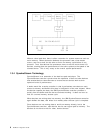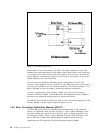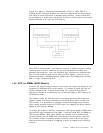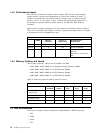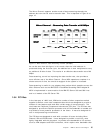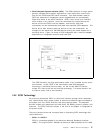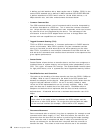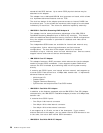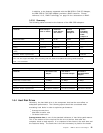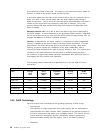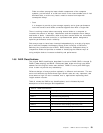
is available with previous bus architectures. In order to optimize performance,
the PCI architecture strictly limits the number of loads (hence the number of
adapters) on the bus. It therefore needs an I/O expansion bus to handle the
more routine I/O devices.
The bus has 32 or 64 bits of address and data, is processor independent and is
capable of speeds over 50 MHz. 8-bit and 16-bit devices are not supported. The
64-bit data bus width in combination with clock speeds over 50 MHz can result in
data transfer of several hundred megabytes per second. In addition to memory
space and I/O space, the bus includes a third address space to support
automatic resource allocation and configuration of system and adapter boards.
Unique features of the PCI include parity on all bus lines and control lines. The
parity is not optional as in other architectures, but is required. All PCI bus
masters must support data streaming to memory devices.
1.6 Disk Subsystem
The disk subsystem is a critical element of server design. In this section we
examine the controllers, the devices, and the interfaces between them. We will
specifically address SCSI technology and also examine RAID technology in some
detail.
1.6.1 Hard Disk Interfaces
The disk interface specifies the physical, electrical, and logical connections
between the controller and the Direct Access Storage Devices (DASD). There
have been four main interfaces developed thus far. Each possesses different
characteristics and performance levels. The interfaces are:
1. ST506 - This interface was the original standard for microcomputers. It has a
data transfer rate of 5 million bits per second (Mbps) between the controller
and the DASD Device. It is a serial rather than a parallel interface. This
interface is classified as a device level interface because the device itself
has no logic to interpret commands. Functions such as formatting, head
selection, and error detection are directed by the controller which is housed
in an adapter card. A device level interface requires specific adapters and
device drivers for each different type of device.
2. Enhanced Small Device Interface (ESDI) - This is an enhanced version of the
ST506 interface. It provides a 10 Mbps data transfer rate (15 Mbps in some
implementations). ESDI devices were the first to use a type of data encoding
called Run Length Limited (RLL) which results in denser storage and faster
data transfer than the older modified frequency modulation (MFM) technique.
However, it is still a device level, serial interface.
3. Integrated Drive Electronics (IDE) - This is a bus level interface meaning that
the device controller is built into the device itself. The IDE interface was
designed for the low cost PC market segment. The interface is flexible and
has been enhanced over time. The latest enhancements include caching at
the adapter level, a CD-ROM interface, and an extension of the maximum
disk storage which was previously limited to 500 MB. However, most IDE
implementations still limit the maximum number of hard disks per interface
to two. This limitation makes IDE more applicable for desktop systems.
16 NetWare Integration Guide



